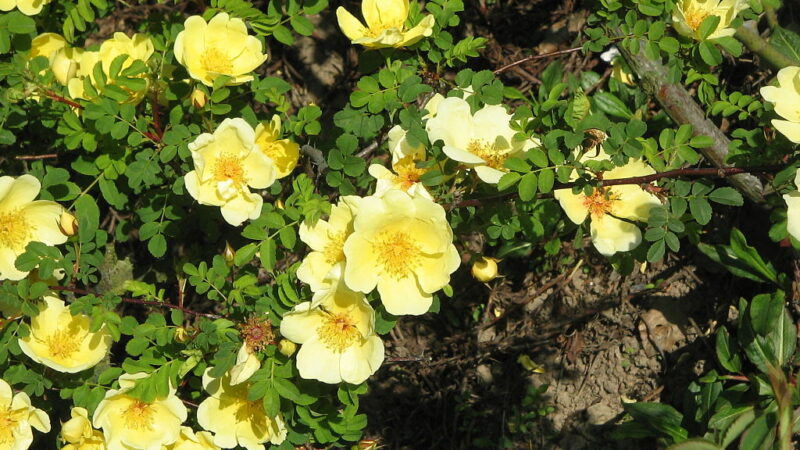Light requirements of the golden rose

The quantity and quality of light a golden rose receives are arguably the most critical factors determining its overall health, vigor, and, most importantly, its ability to produce a spectacular floral display. As a sun-loving species native to open, sun-drenched landscapes, Rosa xanthina has evolved to thrive in bright conditions. Understanding its specific light requirements is fundamental for any gardener wishing to cultivate this plant successfully. Providing the right amount of sunlight not only fuels the essential process of photosynthesis but also plays a vital role in strengthening the plant against common diseases. Proper siting in relation to the sun is the first and most important decision that will set the stage for a thriving, beautiful shrub.
The importance of full sun
The golden rose is unequivocally a full-sun plant. This means that for optimal performance, it needs to be planted in a location where it will receive at least six to eight hours of direct, unfiltered sunlight each day during the growing season. This generous exposure to sunlight is the primary driver of photosynthesis, the process by which the plant converts light energy into the chemical energy it needs to grow, develop strong canes, and produce an abundance of flowers. Without sufficient light, the plant simply cannot generate the energy required for a robust bloom.
In locations with less than the ideal amount of sunlight, the consequences for the golden rose are quite predictable. The most noticeable effect will be a significant reduction in the number of flowers. The plant may still grow and produce foliage, but the stunning, dense cloak of yellow blooms that it is famous for will be sparse and disappointing. The flowers that do develop may be smaller and less vibrant in color. Insufficient light forces the plant to prioritize basic survival over the energy-intensive process of flowering.
Beyond its impact on flowering, sunlight also plays a crucial role in the plant’s structural integrity. A golden rose grown in shady conditions will often become “leggy.” This means it will produce long, weak, and spindly canes as it stretches towards the available light source. This results in a sparse, open, and less attractive overall shape compared to the dense, gracefully arching form of a plant grown in full sun. These weak stems are also more susceptible to being damaged by wind or the weight of any flowers they do manage to produce.
Furthermore, ample sunlight is one of the best preventative measures against common fungal diseases. The morning sun, in particular, is invaluable for quickly drying dew and rainwater from the plant’s foliage. Fungal pathogens like black spot and powdery mildew thrive in damp conditions. When leaves remain wet for extended periods, it provides the perfect environment for these disease spores to germinate and infect the plant. A sunny location promotes good air circulation and rapid drying, creating a much less hospitable environment for these problematic diseases.
More articles on this topic
The effects of insufficient light
When a golden rose is deprived of the sunlight it craves, a cascade of negative effects can be observed, extending beyond just poor flowering. The overall vigor of the plant will be diminished. It will grow more slowly, and its foliage may appear a lighter shade of green than is typical. The leaves may also be smaller and more sparsely arranged along the stems. The plant simply lacks the energy to support robust, healthy growth, making it appear weak and anemic.
A lack of sunlight also makes the plant more vulnerable to pests and diseases. As mentioned, the persistent moisture on the leaves in a shady location encourages fungal growth. A light-starved plant is also a stressed plant, and stressed plants are inherently more susceptible to attack. Their natural defenses are weakened, making them an easier target for sap-sucking insects like aphids or debilitating diseases. A shady spot can initiate a downward spiral of poor health from which it is difficult for the plant to recover.
Another consequence of insufficient light is a reduction in the plant’s ability to prepare for winter. The process of hardening off, where the plant prepares its tissues to withstand freezing temperatures, is fueled by energy reserves built up during the growing season through photosynthesis. A plant that has been struggling in the shade will have fewer energy reserves, making it less hardy and more prone to winter damage or dieback. A sunny location throughout the growing season is therefore essential for its successful overwintering.
If you have a golden rose that is performing poorly, with few flowers and leggy growth, the first thing to assess is its light exposure. It may be that when it was planted, the location was sunny, but over time, nearby trees or shrubs have grown and are now casting too much shade. In such cases, the best course of action is often to transplant the rose to a sunnier location in the garden. While transplanting is a stressful process for the plant, moving it to a site that meets its fundamental light requirements will lead to a dramatic improvement in its health and beauty in the long term.
Site selection for optimal light
Given the critical importance of sunlight, the process of selecting a planting site for the golden rose should be undertaken with careful consideration. The ideal location is one that is open and unshaded for the majority of the day. An east-facing location can be particularly beneficial, as it ensures the plant receives the gentle morning sun, which is crucial for drying the foliage, while also getting sunlight through the middle of the day. A south-facing location is also excellent, providing strong, consistent light throughout the day.
When choosing a spot, it is essential to think about the sun’s path not just on the day of planting, but throughout the entire growing season. The angle of the sun changes, and shadows cast by buildings, fences, or other plants will shift. Also, consider the future growth of surrounding vegetation. A small tree planted nearby might not cast much shade now, but in a few years, it could grow to block the sun from your rose. Always plan for the mature size of all plants in the landscape to avoid future light competition issues.
While full sun is the goal, in very hot climates, a location that offers some light shade during the most intense part of the afternoon can actually be beneficial. The harsh afternoon sun in hot southern or western exposures can sometimes cause stress or scorch the flowers and foliage. However, this is an exception rather than the rule. For most temperate climates, the mantra remains “the more sun, the better.” The plant is far more likely to suffer from too little sun than too much.
Finally, do not forget about air circulation when considering the light. A spot that is sunny but has stagnant air trapped by a solid wall or fence is not ideal. The best location is one that combines full sun with free movement of air. This combination creates the healthiest possible environment for the golden rose, maximizing its potential for a breathtaking floral display and minimizing the likelihood of problems with pests and diseases, allowing its natural beauty to shine.
📷 Meneerke bloem, CC BY-SA 3.0, via Wikimedia Commons

















